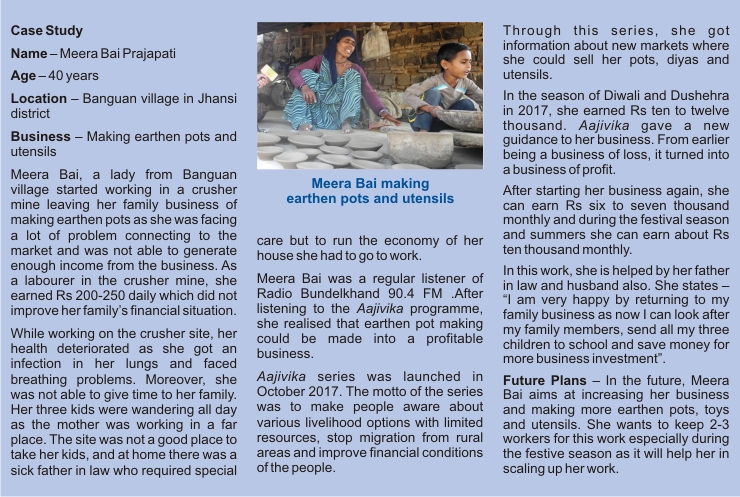|
Role of Grassroots
Communication
Communication for Development ‘Communication for results’ is about designing and implementing strategies to influence change in a desired direction and for that there is need to understand the socio-economic and cultural practices of the communities and also the triggers than can influence behaviour change and how to use those triggers effectively to bring about change. ‘Communication of result’ approach is used by many organisations to scale up development initiatives that have proved to be successful using various communication mediums. The mediums used in both cases vary from films to street plays, community radio etc. Livelihoods in India The Indian economy recorded a fairly high GDP growth rate of 7.2% during 1998-2008. However, this high rate of GDP growth has not translated into inclusive livelihood opportunities for the rural poor. Actually, it adversely impacted the rural poor due to various structural changes in the last ten years. The share of primary sector in GDP declined from 26% to 17.5% between 1998 and 2008, even as the share of rural population, which was dependent on this sector remained the same. This has adversely impacted the livelihood of 98 million small and marginal farm households1. It is important to ensure that those who remain in agriculture are made as efficient and competitive as possible. It is equally important to promote occupational mobility of the rural poor, which is dependent on agriculture and allied activities to attain more gainful non-farm enterprises or employment. Linking communities with information and knowledge about the possible diverse economic opportunities is critical in improving their access to viable sustainable livelihood options. Development Alternatives’ Strategy Over the last three decades, Development Alternatives has designed and implemented communication strategies on various issues to bring about development changes in the communities. The organisation uses both ‘communication for results’ and ‘communication of results’ as part of it’s strategy. Livelihood Campaign Bundelkhand region, comprising of 13 districts (7 in Uttar Pradesh and 6 in Madhya Pradesh) in Central India is one of the most backward regions figuring low on most development indicators. Mainly dependent on agriculture, frequent incidence of drought and rising input costs are pushing agricultural labourers and small farmers out of agriculture. The majority of rural households in most parts of Bundelkhand rely on income from annual or seasonal migration for work. The communities are poorly linked to other sources of sustainable livelihoods - both on farm and off farm and enterprise based livelihoods. Capacity building on livelihood options can play a critical role in addressing this issue and facilitate linking communities to viable sustainable livelihood options appropriate for the region. Grassroots community based organisations could play a critical role in engaging with communities to understand their issues and challenges and link them to experts for addressing their concerns. An approach of capacity building for effective communication and outreach to local communities was used to address the above challenges in partnership with six community based organisations (CBOs) in Bundelkhand. In remote rural areas, community radio is often the only medium available, which is listened to by a large population. Thus, community radio was chosen as the prime tool under the overall communication strategy of the campaign. A total of 210 communication packages (35 communication packages with each of the six CBOs) were developed. These included messages about the need to diversify livelihoods, potential opportunities and also bank linking process for credit/loans, linkages to government and private training centres for enrolment under various training schemes etc. available in the region. These communication modules / packages have been disseminated in the five districts (Ashoknagar, Tikamgarh, Vidisha, Shivpuri and Lalitpur) reaching a population of approximately 12,00,000 through diverse outreach tools such as community radio programmes, community melas, street theatre, folk songs, storytelling and wall paintings. The audio modules have further been used for direct discussion through narrow casting of community radio programmes followed by facilitated Focus Group Discussion sessions between the community and the experts. The outcome of this dissemination is now being studied and feedback is being collected to understand how the community has used the information, what are the new demands for knowledge and whether the intervention has catalysed action on new livelihood creation. While some anecdotal evidence is already available regarding knowledge about credit facilities, enabling an entrepreneur to seek loan and set up a donna-pattal (leaf and paper plates) production enterprise; a systematic feed-back collection is now being initiated. The current findings from community feedback indicate an increased interest in setting up own enterprises. A large number of questions revolve around government training and support schemes, job fairs and bank linkages. ■
Shivani Sharma
Endnote
|
